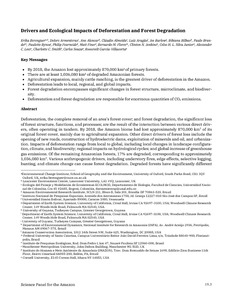Berenguer, Erika, Armenteras, Dolors, Alencar, Ane, Almeida, Cláudio, Aragão, Luiz, Barlow, Jos, Bilbao, Bibiana, Brando, Paulo, Bynoe, Paulette, Fearnside, Philip, Finer, Matt, Flores, Bernardo M, Jenkins, Clinton N, Silva Junior, Celso HL, Lees, Alexander C, Smith, Charlotte C, Souza, Carlos and García-Villacorta, Roosevelt (2021) Chapter 19: Drivers and Ecological Impacts of Deforestation and Forest Degradation. In: Amazon Assessment Report 2021. Technical Report. United Nations Sustainable Development Solutions Network, New York, USA.
![[img]](https://e-space.mmu.ac.uk/628960/1.hassmallThumbnailVersion/Chapter%2019%20211112-Amazon-Assessment-Report.pdf)
|
Published Version
Available under License Creative Commons Attribution Non-commercial Share Alike. Download (3MB) | Preview |
Abstract
Deforestation, the complete removal of an area’s forest cover; and forest degradation, the significant loss of forest structure, functions, and processes; are the result of the interaction between various direct drivers, often operating in tandem. By 2018, the Amazon biome had lost approximately 870,000 km2 of its original forest cover, mainly due to agricultural expansion. Other direct drivers of forest loss include the opening of new roads, construction of hydroelectric dams, exploitation of minerals and oil, and urbanization. Impacts of deforestation range from local to global, including local changes in landscape configuration, climate, and biodiversity; regional impacts on hydrological cycles; and global increase of greenhouse gas emissions. Of the remaining Amazonian forests, 17% are degraded, corresponding to approximately 1,036,080 km2. Various anthropogenic drivers, including understory fires, edge effects, selective logging, hunting, and climate change can cause forest degradation. Degraded forests have significantly different structure, microclimate, and biodiversity as compared to undisturbed ones. These forests tend to have higher tree mortality, lower carbon stocks, more canopy gaps, higher temperatures, lower humidity, higher wind exposure, and exhibit compositional and functional shifts in both fauna and flora. Degraded forests can come to resemble their undisturbed counterparts, but this depends on the type, duration, intensity, and frequency of the disturbance event. In some cases, this may prohibit the return to a historic baseline. Avoiding further loss and degradation of Amazonian forests is crucial to ensure they continue to provide valuable and life-supporting ecosystem services.
Impact and Reach
Statistics
Additional statistics for this dataset are available via IRStats2.



